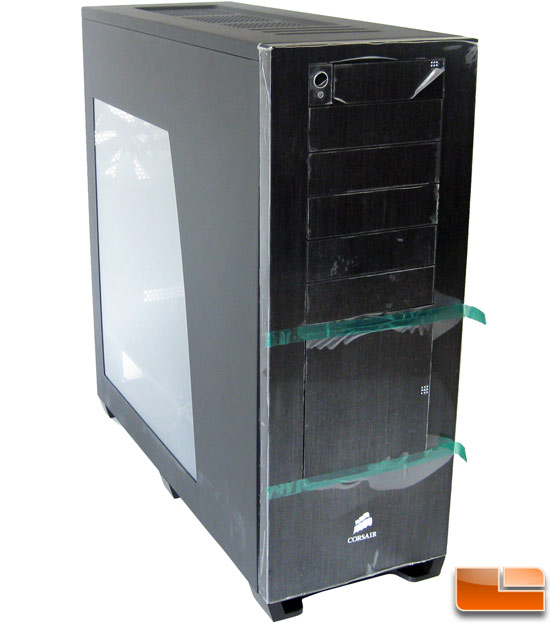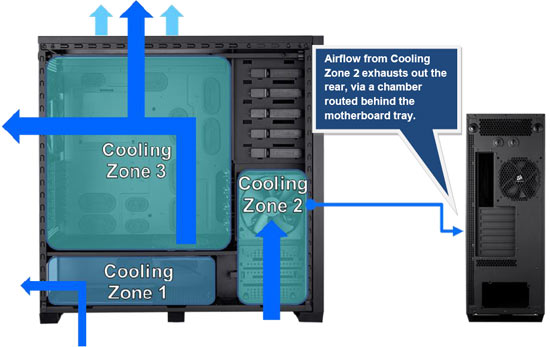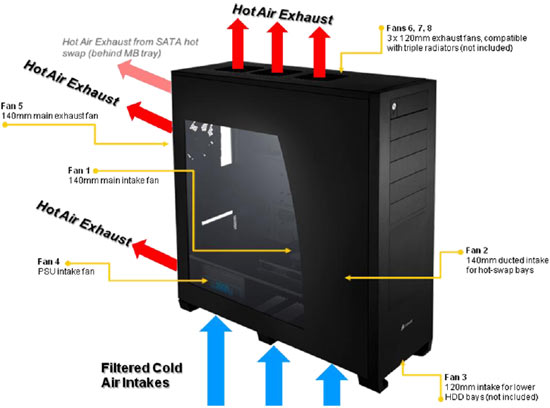Corsair Obsidian Series 800D ATX Chassis Review
The Obsidian 800D Case
Corsair has been hard at work developing a new chassis from the ground up that was aimed at computer enthusiasts from the second they started drawing up plans for the perfect computer case. The first images of the much anticipated Corsair Obsidian Series 800D chassis appeared just before CeBit 2009 and the case was promised to be hitting store shelves in June or July of 2009. Things are taking a little longer than expected as a couple of design changes that they made after listening to consumer feedback from all the CeBit coverage forced Corsair to ‘re-tool’ the factory assembly line. The Obsidian Series 800D might be Corsair’s first step up to the plate for bringing a case to market, but they have taken great strides to make it a success.

Obsidian Series 800D Specifications
| Dimension | 24″ (H) x 24″ (L) x 9″ (W) – (609mm X 609mm X 229 mm) |
| Material | Aluminum Faceplate, Steel Structure |
| Color | Black |
| Model Number | CC800DW |
| Drive Bays | (x5) 5.25″ (x4) 3.5″ SATA Hot Swappable (x2) 3.5″ Internal |
| Cooling | (x3) 140mm Fans Up to 4x 120mm Fans (not included) |
| Expansion Slots | 7 (+1 vent) |
| Motherboard | ATX, mATX, EATX |
| Front I/O | (x4) USB 2.0 (x1) IEEE1394 (x1) Headphone, (x1) MIC |
| Power Supply | ATX (not included) |
As you can see from the specifications the Obsidian 800D is a very large case that has a shipping weight of 44 pounds and it stands proud at a full 24″ in height.

The Corsair Obsidian 800D might be a massive full ATX tower chassis, but it was designed to be a well functioning chassis. Corsair wanted the case to be that large so multi-GPU video card setups could be used as well as allowing custom water cooling kits to be installed. Corsair went into great depth to explain the cooling zones and directed airflow they used in this case, so rather than trying to explain it to you, here is what Corsair has to say about the cooling zones shown in the image above.
- Cooling Zone 1 draws in cold air from underneath the chassis and exhausts it out of the top and rear. Permanently attached aluminum standoffs lift the chassis off the surface to ensure that the cold air intake is not obstructed, while a washable air-filter ensures that dust is prevented from entering the main compartment. This Cooling Zone provides cold air to the motherboard, video card(s) and CPU. The intake and exhaust fans are 140mm units that provide high airflow at a low RPM, are mounted using rubber grommets to dampen vibrations, ensuring a very quiet system. They use standard 3-pin fan connectors and so are compatible with motherboard BIOS fan-control systems.
- Cooling Zone 2 is designed to cool the main storage drives. Although solid-state drives are very cool, several mechanical hard drives can produce plenty of heat. In conventional PC chassis this heat is exhausted into the main motherboard compartment, increasing the ambient temperature for the video cards, CPU and chipset. With the 800D the hot-swap SATA bays are cooled by a separate 140mm fan, and the heat is exhausted via a chamber behind the motherboard tray. The rubber cable mounting grommets in the motherboard tray prevent this heat from entering the main comportment. The lower main storage bay has a 120mm fan mount (the fan is not included), the airflow for which is is also directed behind the lower chamber. A rubber vibration-dampening ring and mounting screws for this fan are included in the accessory kit, should the lower drive bays be utilized. Airflow from Cooling Zone 2 exhausts out the rear, via a chamber routed behind the motherboard tray.
- Cooling Zone 3 allows the PSU to draw in ambient air from beneath the chassis and exhaust it out the rear, without this heat affecting the rest of the PC. Keeping the PSU cool can increase efficiency and longevity. This is especially important for the high-wattage PSUs common in high-end PCs. PSUs that use rear-intake fans instead of bottom-intake fans will still benefit from the cool air in the lower chamber.

To make sure that the cooling zones work, the Corsair Obsidian 800D comes with the ability to have eight case fans installed! (The image above shows nine, but the power supply shouldn’t count.) The case comes with only three 140mm fans when purchased, though, and the rest are up to the consumer to purchase if they want to improve cooling or customize the chassis for their specific application. Now that we know how the airflow works in the Obsidian Series 800D chassis let’s take a closer look at the case itself.

Comments are closed.